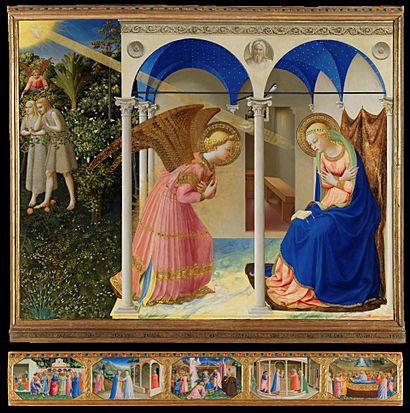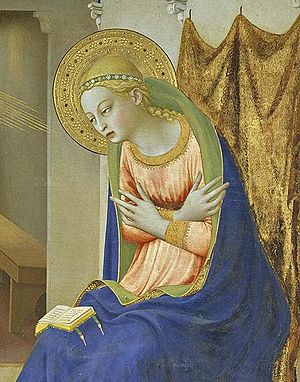Annunciation (Fra Angelico, Madrid) facts for kids
Quick facts for kids Annunciation |
|
|---|---|
| Italian: Annunciazione | |

The main panel
|
|
| Artist | Fra Angelico |
| Year | 1435 ca. |
| Medium | Tempera on panel |
| Dimensions | 154 cm × 194 cm (391 in × 493 in) |
| Location | Museo del Prado, Madrid |
The Annunciation in the Museo del Prado is a famous painting. It was created by Fra Angelico around the 1420s. This artwork was originally made for a church in Italy. It was meant for the Convent of San Domenico in Fiesole. Today, you can see it in Madrid, Spain.
Fra Angelico painted three main artworks showing the Annunciation. This is the moment when the Angel Gabriel tells Mary she will have a baby, Jesus. The Prado version is thought to be the first one he painted.
History
Fra Angelico was a friar, which is like a monk. He painted this artwork for his own church. This was the Convent of San Domenico, Fiesole in Italy. He also painted other important works for this church.
The Annunciation stayed at San Domenico for a long time. In 1611, it was sold to the King of Spain. It then became part of the royal art collection in Madrid. Later, it moved to the famous Museo del Prado.
What the Painting Shows
The painting shows the Annunciation scene. It is divided into three main parts. There is a beautiful garden, the Angel's area, and Mary's area. Fra Angelico used a special art trick called perspective. This makes the painting look deep, like you can walk into it. It helps your eyes focus on the main event inside the building.
In the painting, you can also see Adam and Eve. They are being sent out of the Garden of Eden. Fra Angelico made their figures larger so they are easier to spot.
The garden is full of many different plants and flowers. This type of garden is called a "hortus conclusus". It is a symbol of Mary's purity. Look for the palm tree, which reminds us of Jesus's future suffering. The red roses also point to his sacrifice. Adam and Eve being there reminds us of human sin. But Mary's acceptance of her role brings hope for everyone.
From the top left, a ray of divine light shines down. It goes through a dove, which represents the Holy Spirit. This light touches the Virgin Mary. She is bowing her head, showing she accepts her important duty. Mary is sitting on a fancy seat. She has an open book on her lap. This book is a symbol of the Bible's prophecies coming true.
The Angel Gabriel looks similar to angels in Fra Angelico's other works. His clothes have folds, but they look a bit simpler. This might mean one of Fra Angelico's helpers painted parts of the Angel.
The scene takes place under a beautiful archway. This archway is in the style of the Renaissance period. It looks like buildings designed by the architect Michelozzo. The light in the painting seems to come from one direction. It shines from left to right on everything.
The painting has bright, cool colors like blue and pink. Fra Angelico paid great attention to every small detail. The overall effect is very beautiful and clear.
The Predella
The predella is a long, narrow painting at the bottom of the main artwork. It usually shows smaller scenes related to the main picture. This predella has five scenes from Mary's life:
- Her birth and marriage
- The Visitation (when Mary visits her cousin Elizabeth)
- The Adoration of the Magi (when the Three Wise Men visit baby Jesus)
- The Presentation at the Temple (when Jesus is brought to the temple)
- The Dormition (Mary's death)
Fra Angelico had more freedom when painting these smaller scenes. He could be more creative with their design.
The scene of Mary's marriage shows a Renaissance church in the background. The Visitation scene is also very skillfully painted. The Adoration of the Magi is very special. It shows the Magi from the front, which was new for its time. Fra Angelico used light in a unique way here. It makes the colors bright and clear. This light also helps to bring all the scenes together.
The Presentation scene is also very creative. It shows the temple as a round building. It almost looks like you are looking through a lens. The Dormition scene is more traditional. But the way the mountains in the background create a path for the angels is very clever.
Images for kids
See also
 In Spanish: Anunciación (Fra Angelico, Madrid) para niños
In Spanish: Anunciación (Fra Angelico, Madrid) para niños







